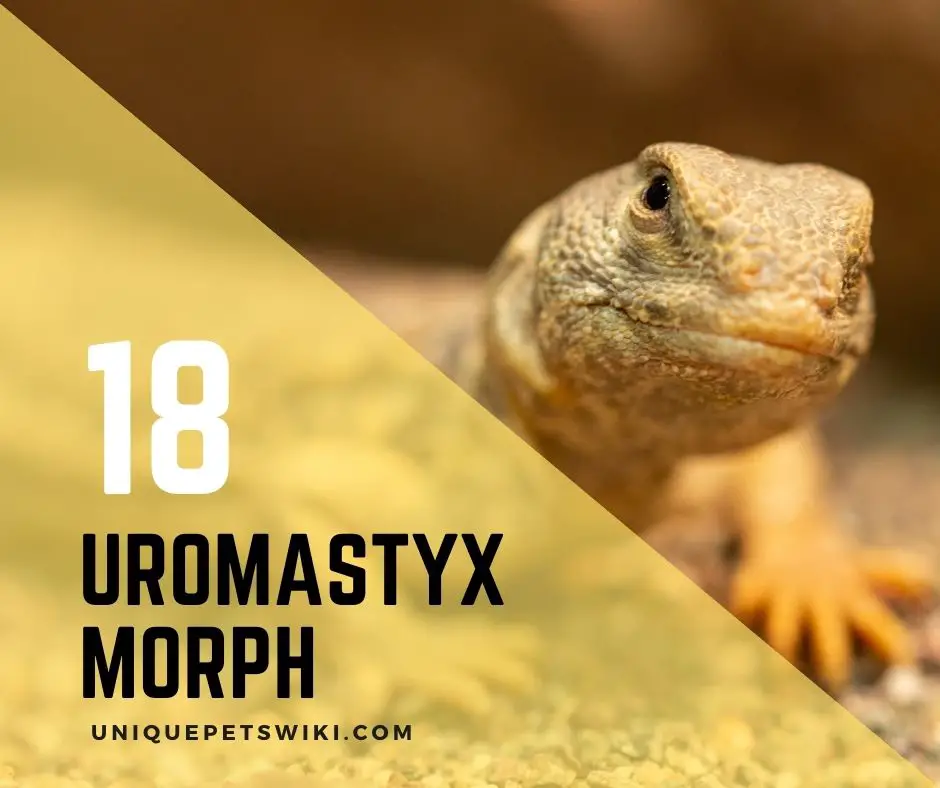The Uromastyx lizards belong to the agamid family, which consists of popular pet lizards like bearded dragons. The Uromastyx lizards are known as spiny-tailed lizards because of their thick, spiky tail that covers about one-third of their body. They originate from Africa, the Middle East, and India and thrive in the desert’s harsh conditions.
Uromastyx lizards are an excellent pet choice for beginners because of their docile temperament, unique appearance, and intelligent nature. Furthermore, there are various species of uromastyx with diverse lovely colorations. This gives you the option to choose one that suits you.
In this post, we will talk about the various types of Uromastyx morphs out there and the best Uromastyx species you can get.
Contents
- What Defines a Uromastyx Morph?
- Uromastyx Morphs List
- Uromastyx Thomasi (Omani)
- Uromastyx Ornata
- Yemeni Uromastyx (Yemenensis)
- Uromastyx Shobraki
- Uromastyx Ocellata
- Uromastyx nigriventris (Moroccan)
- Uromastyx dispar flavifasciata
- Uromastyx Dispar Maliensis
- Uromastyx Acanthinura
- Uromastyx alfredschmidti
- Uromastyx geyri
- Aegyptia (Egyptian)
- Uromastyx Microlepis (Arabian)
- Uromastyx Leptieni
- Uromastyx Macfadyeni (Somali)
- Uromastyx Princeps
- Uromastyx Occidentalis
- Uromastyx Philbyi (Arabian)
- Uromastyx Species & Types FAQs
- Wrapping Up
What Defines a Uromastyx Morph?
The spiny-tailed lizards are a perfect pet for hobbyists if you can provide the appropriate care. There are several numbers of different species of Uromastyx, which shows they are available in a wide range in the wild.
Furthermore, the Uromastyx genus has been recently reorganized, and there are now Uromastyx and closely related genus Saara under the agamid subfamily Uromasticinae.
Uromastyx Morphs List
Here is a list of Uromastyx species morphs that you can find out there.
- Thomasi (Omani uromastyx)
- Ornata
- Yemeni (Yemenensis)
- Shobraki
- Ocellata
- Nigriventris (Moroccan)
- Dispar flavifasciata
- Dispar Maliensis (Mali)
- Acanthinura (African)
- Alfredschmidti
- Geyri (Saharan)
- Aegyptia (Egyptian)
- Microlepis (Arabian)
- Leptieni
- Macfadyeni (Somali)
- Princeps
- Occidentalis
- Philbyi (Arabian)
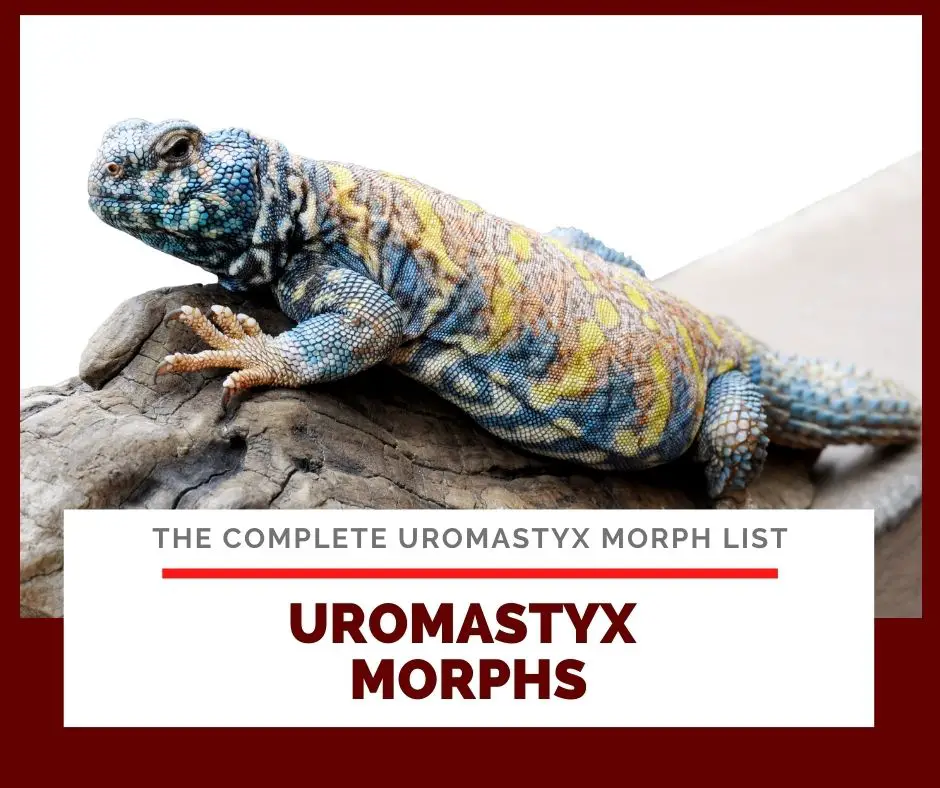
| Name | Where does the morph come from? | Main colors/pattern | Price ($) |
| Thomasi (Omani uromastyx) | They originate from Oman | It is mainly a lightly colored body with green, brownish, pinkish, blue, cream, with black or grey specks. | 999.99 |
| Ornata | Uromastyx Ornata originates from regions between Egypt, Israel, Sinai deserts, and western parts of Saudi Arabia. | Uromastyx Ornata can develop lovely colors such as green, turquoise, and yellow; some are red and cobalt. | 349.99 |
| Yemeni (Yemenensis) | They originate from Yemen on the south Arabian coast. | They are popularly known as rainbow uromastyx due to their mind-blowing coloration. They possess rows of white lines on their back, and their body coloration ranges from grey, brown, blue, yellow, pink, etc. | |
| Shobraki | They originate from Yemen | They are popularly known as rainbow uromastyx due to their mind-blowing coloration. They possess rows of white lines on their back, and their body coloration ranges from grey, brown, blue, yellow, pink, etc. | |
| Ocellata | They originate from Somalia, Ethiopia, and Ethiopia, and can also be found in Eritrea, Djibouti, and southern Egypt. | Their major color lines are olive green and brick red. They also have white ocelli (circles) on their backs that are surrounded by other colorations. | 199.99 |
| Nigriventris (Moroccan) | They originate from North Africa in Morocco and part of Algeria. | Baby Moroccan uromastyx are usually tan brown but develop beautiful colors as they age. You will start seeing yellow or red coloration on their body once they are about 2-3 years old. | 149.99 |
| Dispar Flavifasciata | They originate from the desert areas in Algeria, Niger, Mali, and Mauritania. | Baby Dispar flavifasciata have beige colors, and they later develop black, orange, white, or orange color as they age. Some can even become fully black but with colored stripes. | 99.99 |
| Dispar Maliensis (Mali) | They originate from northwestern Mali and southwestern Algeria. | Baby Maliensis start with beige or brownish colors that develop to yellowish coloration as they age. Maliensis Uros bodies are usually solid black, which includes the head | 99.99 |
| Acanthinura (African) | They originate from Algeria, Morocco, Libya, Mauritania, and Tunisia. | They are similar to Moroccan Uromastyx, but they develop less coloration as they age. They also do not develop any green, red, or bright yellow coloration. | 199.99 |
| Alfredschmidti | It is usually found in southwest Libya and southeastern Algeria. | They have darker colorations | |
| Geyri (Saharan) | They originate from Nigeria, Niger, and Mali | They have orange or citrus coloration with black lines and specs around their body. | |
| Aegyptia (Egyptian) | They originate from the Egyptian deserts but also in Palestine, Libya, and Israel. | They are usually beige to brown in color. | 349.99 |
| Microlepis (Arabian) | They originate from Kuwait, Yemen, Saudi Arabia, UAE, Qatar, Iran, Jordan, Iraq, and Syria. | Baby Microlepis have yellow and some stripes while the adults become uniformly tan, cream, brown, and yellow-colored. | |
| Leptieni | They originate from UAE and Oman. | They are similar to Egyptian uromastyx | |
| Macfadyeni (Somali) | They originate from Somalia | Baby Macfadyeni starts with simple beige colors that later develop into colorful adults. They usually have turquoise or blue color with yellow spots on their back and belly. | |
| Princeps | They are endemic to Somalia and can also be found in eastern Ethiopia | Baby U. Princeps are usually beige in color, but they develop to beige, yellowish, or bluish color as they age. | 1,199.99 |
| Occidentalis | It originates from Western Sahara | They are similar to Egyptian uromastyx | |
| Philbyi (Arabian) | They originate from Saudi Arabia and Yemen | They develop lovely colors like red, blue, and green. | 299.99 |
Uromastyx Thomasi (Omani)
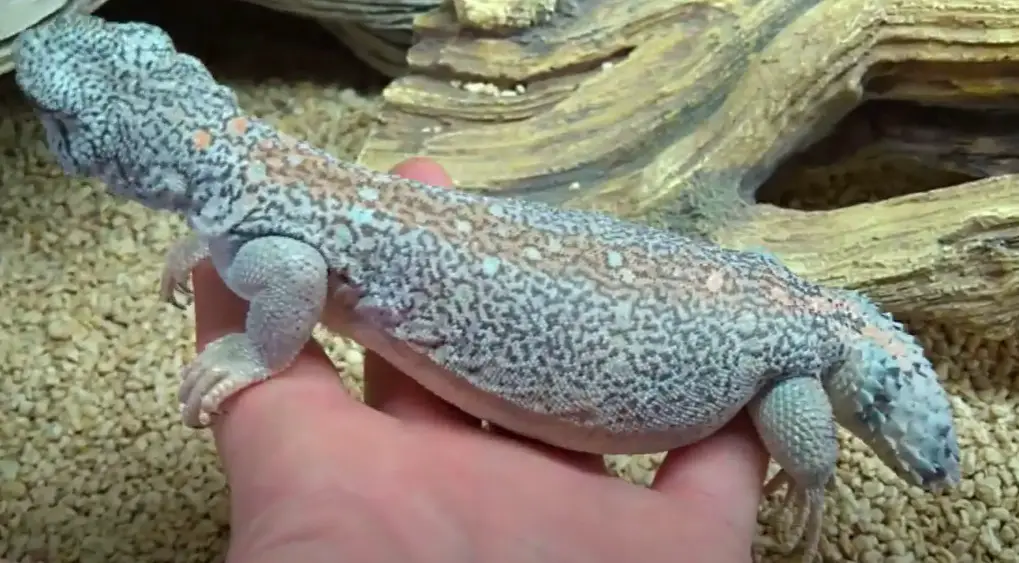
Uromastyx Thomasi originates from Oman, and they possess a short and round tail with short spines that makes them unique from other Uros. They are small to medium-sized uros species and can grow to about 9-10 inches long. Omani uros have a round tail similar to U. princeps, but their tail is flatter.
Furthermore, they have femoral pores close to their cloaca.
Although their coloration can be different, it is mainly a lightly colored body with green, brownish, pinkish, blue, and cream, with black or grey specks. You can also find a line that runs along their back that is usually orange in color, and the intensity of their body coloration is different between individuals.
Uromastyx Ornata

Uromastyx ornata originates from regions between Egypt, Israel, Sinai deserts, and western parts of Saudi Arabia. They are medium-sized colorful lizards and can grow to about 12-14 inches long.
They are among the most popular Uros species that you can keep at home, and they are closely related to the ocellata group. Uromastyx Ornata can develop lovely colors such as green, turquoise, and yellow; some are red and cobalt.
Most of them have a mixture of colors, while some have stripes or dots around their head. They have sexual dimorphism, as the males are more colorful than the females. Furthermore, it can take 3-6 years for Uromastyx ornata to develop colors properly.
Yemeni Uromastyx (Yemenensis)
Yemeni Uromastyx originates from Yemen on the south Arabian coast. They are popularly known as rainbow Uromastyx due to their mind-blowing coloration. They possess rows of white lines on their back, and their body coloration ranges from grey, brown, blue, yellow, pink, etc.
The males are usually more colorful than the females, and their throats are black or dark blue. Yemeni Uromastyx can grow to about 13-14 inches in length. Uromastyx Yemeni will make a great pet, and they can become very docile. However, it can be hard to get them in pet stores or online.
Uromastyx Shobraki
Uromastyx Shobraki originates from Yemen. However, they usually get a bit larger than U Yemenensis as they can grow to about 15 inches in length. They have a look similar to the Benti uros but are genetically different.
However, you are unlikely to find Shobraki species for sale because they are vulnerable species.
Uromastyx Ocellata
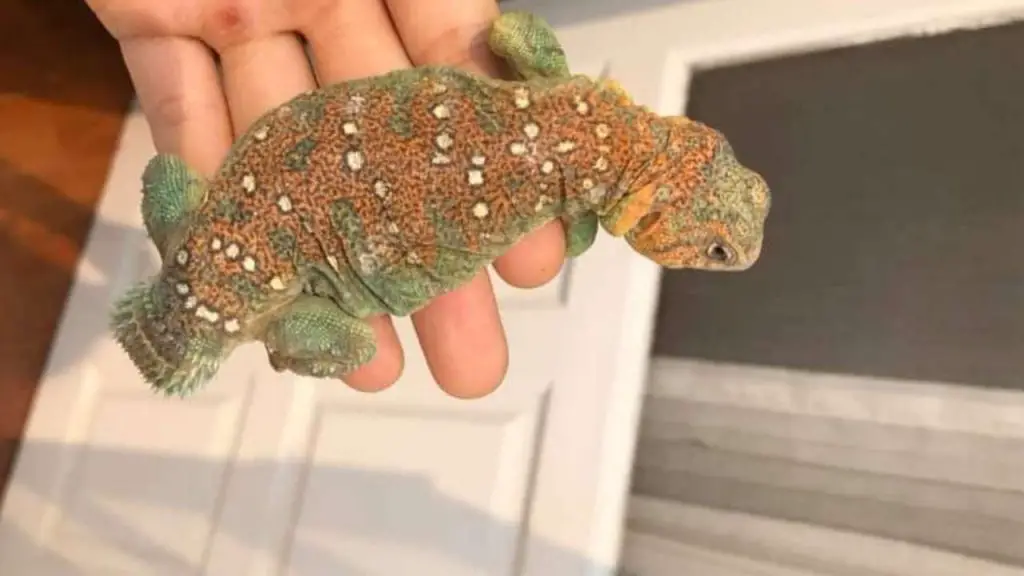
Uromastyx ocellata originates from Somalia and Ethiopia, and can also be found in Eritrea, Djibouti, and southern Egypt. They are commonly kept as a pet and usually have a docile and friendly temperament. They are among the smaller Uros species and can grow to about 11-12 inches long.
Their major color lines are olive green and brick red. They also have white ocelli (circles) on their backs that are surrounded by other colorations.
Uromastyx nigriventris (Moroccan)
The Moroccan Uromastyx originates from North Africa in Morocco and part of Algeria. They belong to the Acanthinura species and can prefer living in harsh desert conditions. They are considered to be a larger species of Uromastyx and can grow to about 15-17 inches in length.
Baby Moroccan Uromastyx are usually tan brown but develop beautiful colors as they age. You will start seeing yellow or red coloration on their body once they are about 2-3 years old.
However, both males and females develop similar colors and have several small specs on their backs. They are considered good pets and are usually available as a captive breed because of the country’s export limitations.
Uromastyx dispar flavifasciata
Dispar Flavifasciata originates from the desert areas in Algeria, Niger, Mali, and Mauritania. They are considered as larger Uromastyx species and can grow to about 19.6 inches in length. They are also known as banded Uromastyx due to 5-7 bands on their backs that develop as they age.
Furthermore, baby Dispar flavifasciata has beige colors, and they later develop black, orange, white, or orange colors as they age. Some can even become fully black but with colored stripes. Although Dispar flavifasciata is stunning, it is usually harder to find them in pet stores and online.
Uromastyx Dispar Maliensis
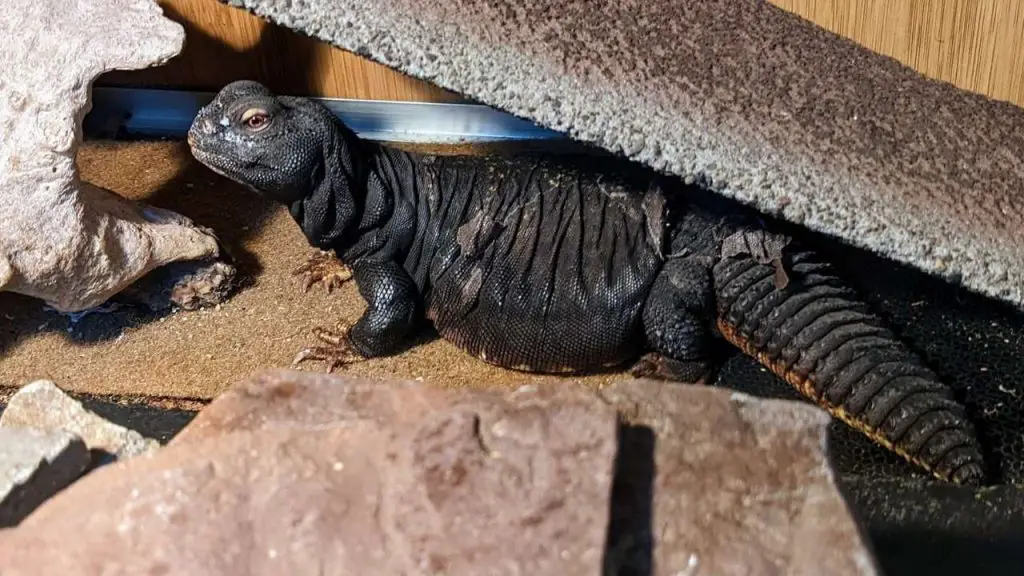
Maliensis uros are quite similar to Flavifasciate, but they do not have bands on their backs. They are medium-sized spiny-tailed lizards and can grow to about 12-16 inches, with males larger than females. Baby Maliensis start with beige or brownish colors that develop to yellowish coloration as they age.
Maliensis uros bodies are usually solid black, which includes the head and the stunning contrast of colors makes them mind-blowing. Furthermore, some individuals (usually females) may have beige or lighter coloration.
Uromastyx Acanthinura
The Acanthinura uros is also known as African uromastyx. They originate from Algeria, Morocco, Libya, Mauritania, and Tunisia. Furthermore, they are similar to Moroccan Uromastyx, but they develop less coloration as they age. They also do not develop any green, red, or bright yellow coloration.
They are among the large Uromastyx species as they can grow to about 16-17 inches in length.
Uromastyx alfredschmidti
Uromastyx alfredschmidti is also known as Schmidt’s Spiny-tailed lizard, is usually found in southwest Libya and southeastern Algeria. They are genetically similar to Uromastyx Geyri but with different body morphological differences.
Furthermore, they have larger triangular pores on the sides of their body between the hips and belly. They also have darker colorations, and it can be hard to find them as pets because they are vulnerable in the wild.
Uromastyx geyri
Uromastyx geyri originates from Nigeria, Niger, and Mali. They are among the smaller species of Uros, and they can grow to about 10-14 inches in length. Although the females have vibrant colors, the males develop more vibrant colors as they age.
They have orange or citrus coloration with black lines and specs around their body. They are a perfect pet that you can keep at home, and the best thing is that they are generally not hard to find.
Aegyptia (Egyptian)
The Egyptian uromastyx originates from the Egyptian deserts but also in Palestine, Libya, and Israel. They are known as the largest species of uros as they can grow to about 30-36 inches in length. Although they are big, they are curious and calm creatures that you can keep as a pet.
Egyptian uros do not usually climb that much, and you will need to provide them with a lot of floor space with low branches or stones for basking. Furthermore, they don’t develop many colorations, and they are usually beige to brown in color.
They also possess a lot of small scales on their back with a yellowish belly. Although you can easily get a captive-bred individual of these species, they become more vulnerable in the wild.
Uromastyx Microlepis (Arabian)
Uromastyx microlepis belongs to the group of Aegyptia uromastyx. However, they originate from Kuwait, Yemen, Saudi Arabia, UAE, Qatar, Iran, Jordan, Iraq, and Syria. They can also grow to about 30 inches in length, and they have similar coloration with Egyptian uros.
However, baby microlepis have yellow and some stripes while the adults become uniformly tan, cream, brown, and yellow-colored. Although they are very friendly, it can be hard to get them.
Uromastyx Leptieni
Uromastyx leptieni belongs to the group of Egyptian uromastyx. They originate from UAE and Oman. Furthermore, they can reach similar sizes as Egyptian uromastyx. They are quite hard to find and are not as popular as other pets.
Uromastyx Macfadyeni (Somali)
The Uromastyx macfadyeni originates from Somalia, and they have morphological similarities to U. ornates. They are also known as the smallest species of uros as they only grow to about 8-9 inches in length. Baby Macfadyeni starts with simple beige colors that later develop into colorful adults.
They usually have turquoise or blue color with yellow spots on their back and belly. Furthermore, they have a rather long tail with sharp spikes. Although they will make a good pet, it can be quite harder to find one for sale.
Uromastyx Princeps
Uromastyx princeps are among the smaller species of uros and can grow to about 10 inches long. They are similar to U. thomasi with their short tail, but it is not as flat. Their tail also features large spikes, and they do not have femoral and preanal pores.
Baby U. princeps are usually beige in color, but they develop to yellowish, or bluish color as they age. Furthermore, their tails develop red or yellow coloration. The males are also more colorful than the females as they develop extra coloration on their bellies.
Uromastyx Occidentalis
Uromastyx occidentalis originates from Western Sahara, and it is believed to be related to the Egyptian uromastyx. There has been little research done on them, and they are usually not available as pets.
Uromastyx Philbyi (Arabian)
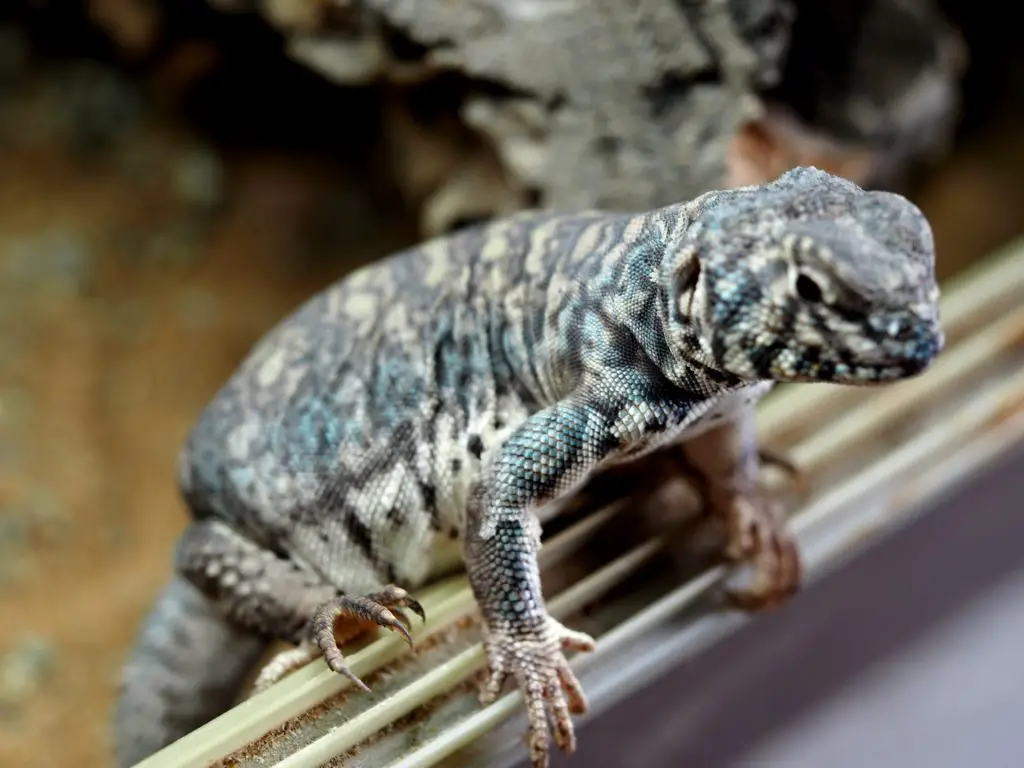
U. Philbyi is also known as Arabian uromastyx. They are directly linked to U. ornate but are much smaller and can grow to about 12-13 inches in length. They also develop lovely colors like red, blue, and green. Furthermore, males become more colorful than females as they age.
However, they make great pets but can be quite hard to find.
Uromastyx Species & Types FAQs
What is the best breed of uromastyx?
Each uromastyx has its special appearance and personality. Some of the most popular uromastyx morphs include the Algerian Uromastyx, Moroccan Uromastyx, and Sudanese Uromastyx. Ultimately, it is up to the individual owner to decide what the best breed of uromastyx is.
What is the largest uromastyx?
The largest uromastyx is the Moroccan Uromastyx. These lizards can grow up to 3 feet long (36 inches) and weigh over 2 pounds.
What is the smallest uromastyx?
The smallest uromastyx is Uromanbyx Hardwicki, which lives in the northwest part of India and Pakistan. The majority of “hardwicks” measure 10 inches long.
How many uromastyx colors are there?
There are many uromastyx colors, but the most common are green, blue, and orange. There are also less common morphs such as albino, leucistic, and melanistic.
Wrapping Up
All uromastyx species are mind-blowing, and they will make great pets, but some are usually shy and require more work.
